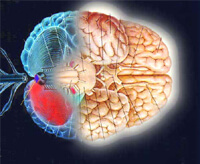Mosaicism
 Mosaicism is a pathological form of combining different genetic materials. The causes of this pathology are very diverse, and some even have not been sufficiently studied. Most often forms of mosaicism provoke mutations and influence on the dividing cell. Like any mutation, mosaicism can have different outcomes, depending on its shape. There are neutral, harmless mutations that do not affect pathogenesis and life prediction or lead to pathologies. Such mosaicisms are studied by a genetic doctor and require detailed studies to prevent the transmission of such pathologies. It should be noted that this pathology is rarely encountered, but leads to a variety of outcomes and in some cases mosaic pathologies proceed more easily than not mosaic, but simply chromosomal.
Mosaicism is a pathological form of combining different genetic materials. The causes of this pathology are very diverse, and some even have not been sufficiently studied. Most often forms of mosaicism provoke mutations and influence on the dividing cell. Like any mutation, mosaicism can have different outcomes, depending on its shape. There are neutral, harmless mutations that do not affect pathogenesis and life prediction or lead to pathologies. Such mosaicisms are studied by a genetic doctor and require detailed studies to prevent the transmission of such pathologies. It should be noted that this pathology is rarely encountered, but leads to a variety of outcomes and in some cases mosaic pathologies proceed more easily than not mosaic, but simply chromosomal.
Mosaicism - what is it?
To talk about mosaicism, you need to repeat the genetics a little and remember that any multicellular organism that has sexual fertilization, rather than division or parthenogenesis, comes from one egg, fertilized by the male genetic material. During the growth of the zygote, a multi-stage division occurs, but all cells in the body have the same genetic set, that is, karyotype and genotype. But in people with mosaicism, several genetic sets can be formed due to various, as a rule, unfavorable factors. Then the body has normal healthy cells and mutated cells.
Mosaicism is derived from France and takes the foundations from the word mosaic. From the Latin "musivum", which means dedicated to the muses. This phenomenon is formed when there are two different types of genes in cells, cells of different genotype. From mythology there is a likeness of such a being, it is called a chimera and is collected from several different animals. This image is a prototype of mosaicism, which comes from several genotypes.
Genetic mosaicism is not possible in all chromosomes, but only in individual sets, which leads to an incomplete and heterogeneous spread of the lesion.
Mosaicism can arise in the sex cells, with direct exposure to unfavorable factors. The mutation is inherited randomly, violating the traditional Mendelian inheritance. This leads to the fact that pathology will not be found in all children of sick parents, but selectively. Somatic cells can also undergo mosaicism, but it is not transmitted in the generation, because somatic chromosomes are not carriers of gene information for generations, they affect the life of its carrier when they manifest. The phenotype, that is, external signs of a genotype, a set of chromosomes, are formed depending on the manifestation of pathological alleles.
Chromosomal mosaicism is common in abnormal pathologies of sex chromosomes. In doing so, it gives its individual signs of different mosaic diseases.
Placental mosaicism is a separate form, the possibility of detection of which appeared only with the methods of intrauterine invasive examination of parts of the fetus, child's place and amniotic fluid. It manifests itself in the intrauterine underdevelopment of the crumbs due to the pathology of the placenta, which is inherent in the mother genetically due to mosaicism. Moreover, the fetus has absolutely unquestionably a normal karyotype consisting of 23 pairs of chromosomes, one of which is sexual and no other extragenital or obstetric problems are detected.
Mosaicism: causes of
The reasons for mosaicism always have their own negative outcomes or consequences. For their understanding, a basic knowledge of molecular biology and subspecies of cell division is required.
Genetic mosaicism can often occur with meiosis, division, which leads to the formation of haploid, that is, having a half-set of cells. In this case, there is a normal doubling of the material in the first division cycle, and the next does not occur. But in some cases, a significant malfunction may occur in one of the phases of meiosis, which will lead to abnormal cell division. This can occur in several phases of meiosis, since meiosis has many phases. In the prophase there is a conjugation leading to the convergence of chromosomes with the appearance of bivalents, and in the subsequent crossing-over. It is at the stage of crossover that a failure can form, which will lead to the creation of mosaic cells. Chromosomal mosaicism is formed precisely with this outcome and is possible in every organism cell as a whole. In true outcomes, crossing-over is a normal process necessary to increase the variability of organisms, but with an incorrect outcome, violations are possible, among which there is also mosaicism.
The reasons for the mutations leading to mosaicism can be many, including bad habits, and all kinds of emissions, and the influence of mutagens. If the mutation occurs at the zygote stage, as fusion cells, or at the extremely early stages of fragmentation, then the effect is only on the fetus, and if in the sex chromosomes, then the effect can be on all children.
But on the meiosis prophase there do not end the danger in the appearance of problems with division, with the discrepancy of chromosomes, incidents leading to similar forms of pathologies are also possible. Such an incorrect division of chromosomes occurs in the cell nucleus, because it is responsible for the reproduction of cells.
Depending on the time of origin of the mutation, mosaicism may affect the entire fetus, and may affect only one of the embryonic sheets. That is, to strike only ecto-, meso-, or endoderm. This will subsequently lead to the fact that mosaicism will be found only in all formations from that leaf. For example, when the endoderm is affected, these are all organs, mesoderms are muscles, vessels, bones and all connective tissues, and ectoderms are the outer shells and organs of perception.
Placental mosaicism is formed in cases of trisomy of the zygote along one of the pairs of chromosomes, when some pair has tripled. This is called aneuploidy, because the chromosome set is not a multiple of the haploid set. In this case, after trisomy, some of the cells remained normal while correcting the errors, and some of them were tripled. This will lead to the fact that the trophoblast with which the fetus feeds will have a set of chromosomes different from the fetus.
Mosaicism:
Symptoms There are no distinct characteristic symptoms for mosaicism, they are diverse and vary greatly from the kind of mutations and cells that have undergone it. They can be expressed in a variety of chromosomal diseases or be completely harmless.
Placental mosaicism has such characteristic criteria: underdevelopment and delay of intrauterine development. A lot of spontaneous miscarriages occur for such reasons. Often such children have premature birth. However, chromosome anomalies can not be distinguished from such signs, it is necessary to carry out genetic studies: karyotyping, amniocentesis, chorionic villus biopsy with cytogenetic research.
Genetic mosaicism is often manifested in individual symptoms. A typical example are different eyes, with different iris color. Also manifested in the asymmetry of the body, irregular pigmentation or limbs of different lengths. To identify the karyotyping, the study of cultures of fibroblasts.
Chromosome mosaicism has many genetic syndromes in its structure. Mosaic Klinefelter syndrome manifests itself in men, as a rule is expressed weaker than a full-fledged form of the disease. At the same time, they doubles and sometimes triple chromosome X, which often leads to effeminacy, infertility and problems in terms of men's health. Hermaphroditism is also often of a mosaic nature and is manifested by the birth of a child with different sex characteristics, for example, male internal male organs and external female genital organs. There are other more unfavorable aggregates. Shershevsky-Turner syndrome manifests itself in girls with a zero X chromosome and leads to infertility, lack of expression of secondary sexual characteristics and folds on the neck. The mosaic form of Down syndrome is also much easier than its full-fledged fellow, but has the same symptoms: inhibition in development, a special appearance, additional pathologies of internal organs. The definition of mosaic forms is difficult, because you need to look at more than one cell. Manifestations also vary from the degree of penetration of genes. That is why there are many transitional forms between sexual genetic syndromes and healthy people, which have high chances of having offspring.
Mosaicism: treatment of
Mosaic pathologies are incurable due to a modified genotype, but still many symptoms can be improved and it is necessary to do so. It is important to realize that such parents need to be examined by geneticists and warned about such pathologies with the help of family planning cabinets, in particular, if there are problems with one child.
Treatment of individuals with mosaicism varies greatly depending on the pathology it provokes. Since the severity of the symptoms may manifest itself less in the mosaic form of pathology, then treatment is required less intensive. With hermaphroditism, the parents must definitely decide at will with the child's sex. After this, surgery is performed with the formation of internal( if necessary, if they are not same sex) and external genital organs, followed by sex hormone replacement therapy in the right age range and for life that allow the baby to live a normal life of a certain sex.
With Down syndrome, everything is focused on the symptomatology, its cupping. With heart diseases, these are beta-blockers, digoxin, Furosemide and surgical intervention on the cardiac system. With syndrome states: Klinefelter and Shershevsky-Turner syndromes there is no specific treatment, but considerable patience is required with the work of a psychologist in such individuals, due to their significant differentiation with other persons.



